Zebra Finches
ALL OF THESE ZEBRA FINCHES ARE FOR PICK UP ONLY IN READING P.A. AND YOU MUST CHECK FOR AVAILABILITY BY E-MAIL FOR ALL COLORS. THEY ARE AVAILABLE STARTING AT AGES 2 MONTHS AND UP. I AM A HOBBY BREEDER AND FEED THESE FINCHES VERY WELL WITH A VARIED DIET OF SEEDS, EGG FOODS, LETTUCE, MILLET, VITAMINS, FRESH WATER DAILY. THEY ARE PLUCK FREE AND EXTREMELY HEALTHY WITH VIBRANT FEATHERS LIVING COMFORTABLY WITH PLENTY ROOM TO FLY AND SOCIALIZE. BELOW ARE THE MUTATIONS AND PRICE LISTS. YOU CAN ASK TO BE ON A WAITING LIST FOR THE MORE POPULAR DEMAND BIRDS IF THEY ARE NOT AVAILABLE AT THE TIME YOU WOULD LIKE.
LEAVE COMMENTS AND/OR QUESTIONS IN THIS SECTION
THERE ARE ALWAYS SPECIALS ON THE COLOR SPLIT ZEBRA FINCHES.....
~THE NORMAL COLOR SPLIT PRICES ARE HALF OFF THE ORIGINAL FULL COLOR PRICE, CONTACT FOR AVAILABILITY~
chestnut flanked white male
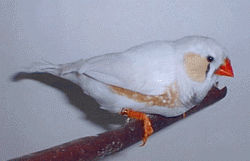
Chestnut Flanked White (CFW for short) causes the body colour of the bird to lose or almost lose colour.This is a sex-linked recessive mutation.There are two different CFW mutations, one red-eyed and one black-eyed. The two mutations are multiple alleles, with the black-eyed dominating over the red-eyed. The black-eyed was the first to appear. They usually have clear white backs/wings, but often with a few grey shadows.The red-eyed have pale cream backs and rarely any shadows. Their black markings are usually better than those of the black-eyed. Here is the chestnut flanked white male with black eyes the male is $15 each or $25 per pair contact for availability [email protected]
chestnut flanked white female
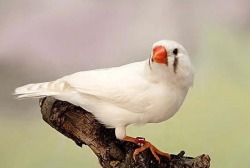
here is the chestnut flanked white female $15 each or $25 per pair. e-mail for availability [email protected]
Florida Fancy male
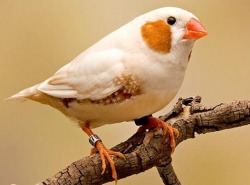
Male: The Florida Fancy mutation works to suppress all the Black coloration (eumelanin) on the bird. This creates a nearly all white bird with the orange markings remaining at full strength. There will often be some orange lacing in the wings. If not a pure white, there can be a hint of a silver color when seen in certain light. The belly will often be a rich creamy buff color.
Female: Like the male, the gray and black coloration has been eliminated and a silvery white color will remain. The buff belly and tail, also present in the males, is often more rich in the hens. The orange lacing however is often not as pronounced as in the males. These are truly pretty zebras. The perfect Florida Fancy has a near white upper body (head, back, wings, etc) and white breast with no hint of any markings, rich buff underparts from the breast bar region down to the vent. The Cheek patches and flanking in males is just as vivid in color as that of any normal Grey zebra. This feature makes the Florida Fancy Zebra striking. Females are like the males in body color except that they lack the orange marking. The most notable feature of this mutation is that it completely lacks any black pigment.
The Florida Fancy is $20 each or $30 per pair contact for availability at [email protected]
Female: Like the male, the gray and black coloration has been eliminated and a silvery white color will remain. The buff belly and tail, also present in the males, is often more rich in the hens. The orange lacing however is often not as pronounced as in the males. These are truly pretty zebras. The perfect Florida Fancy has a near white upper body (head, back, wings, etc) and white breast with no hint of any markings, rich buff underparts from the breast bar region down to the vent. The Cheek patches and flanking in males is just as vivid in color as that of any normal Grey zebra. This feature makes the Florida Fancy Zebra striking. Females are like the males in body color except that they lack the orange marking. The most notable feature of this mutation is that it completely lacks any black pigment.
The Florida Fancy is $20 each or $30 per pair contact for availability at [email protected]
Florida Fancy Pair
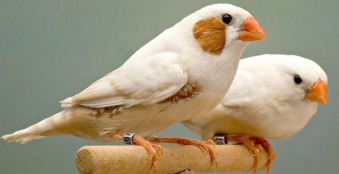
The Florida Fancy mutation works by reducing the level of eumelanin (gray and black color in the normal Zebra finch coloration). It does not alter the Phaeomelanin or orange coloration of the plumage, mostly seen in males. The method of inheritance of the Florida Fancy is autosomal co-dominant. As you can see in this pic of the hen there is no tear markings what so ever on her face.
The Florida Fancy is $20 each or $30 per pair contact for availability [email protected]
The Florida Fancy is $20 each or $30 per pair contact for availability [email protected]
Gray Cheeked pair
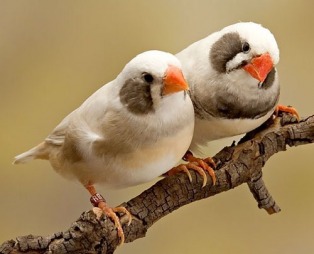
Male: The Fawn Cheek (FC) mutation reduces the gray areas of the Zebra finch to a white or near white color. The cheek patches are also changed in that they show the base body color. That is to say that Gray series birds will have a gray cheek patch (often called a Gray Cheek or GC) and fawn series birds will have a fawn cheek patch. The flanks remain unchanged, but the breast bar and tear marks can often be reduced in intensity giving them a softer appearance. There is often some fawn lacing in the wings and the belly will retain any buff coloring. The tail bars are also distorted. The Gray cheeked male is $30 each or $50 per pair for a lighter gray cheek patch it would be $25 each or $45 per pair this is the same price for the fawn cheeked contact for availability [email protected]
Gray Cheeked hen Fawn Cheeked male
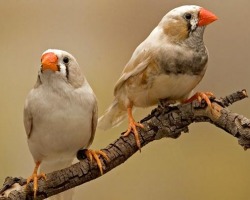
Female: The base color will be reduced to white or near white as in the male. With this mutation, like the Black Cheek mutation, the hens have cheek patches like the males. They can still be distinguished by the lack of flank markings, breast bars and the lighter colored beak. The buff coloring on the belly is usually more evident on the females than the males. The Gray cheeked hen is $30 each or $50 per pair for the lighter gray cheek patch the price is $25 each or $45 per pair this is the same price for the fawn cheeked, contact for availability [email protected]
Black Face Male (close up)
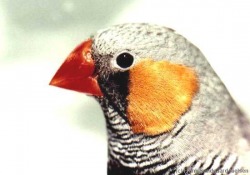
Male: The space between the tear mark and the beak (lores) is changed from white to black and the breast bar is extended towards the vent making the underside of the male black. The extent of the black is variable. The flanks have a tendency to lose the spots, but this is not so in all cases. The tail coverts also carry more black. The white bars are more narrow. The Black Face male is $35 each or $60 per pair contact for availability [email protected]
Black Face Female
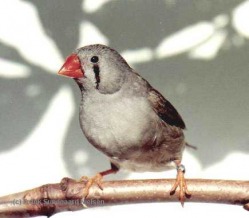
Female: Black Face females have only subtle differences from normal hens and are easily passed over. The white between the tear mark and the beak is gray instead of buff white and there is often an extension of gray down from the breast. The tail bars are similar to males. because of these subtle marks, it can sometimes be difficult to distinguish BF hens from normals. The Black Face female is $35 each or $60 per pair contact for availability [email protected]
Black Breasted Male
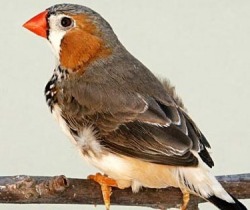
Male: Every marking on the Black Breasted finch is altered in some way. The cheek patches are enlarged, feathering at the outer edges. The tear mark is missing. The flank spots are elongated and enlarged, sometimes to the point that it looks as though the flank has been replaced with chestnut colored spots or streaks. The upper tail coverts are buff colored and the tail bars are elongated so that they run vertically on the tail coverts. The breast bar is enlarged, giving the mutation its name. Often, there is also some orange or white lacing on the wings. The Black Breasted male is $40 each or $70 per pair contact for availability [email protected]
Black Breasted Pair

Female: The tear mark is missing and the rump and tail are buff colored like the males. As with the males, there can be some orange or white lacing on the wings.
Fledgling: Black Breasted chicks can be identified in the nest. They resemble females with buff cheeks and tail coverts. The tail lacks the bars. They look a little like Penguin Zebra finches. The Black Breasted female is $40 each or $70 per pair contact for availability [email protected]
Fledgling: Black Breasted chicks can be identified in the nest. They resemble females with buff cheeks and tail coverts. The tail lacks the bars. They look a little like Penguin Zebra finches. The Black Breasted female is $40 each or $70 per pair contact for availability [email protected]
black cheek male
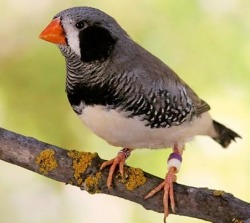
The Black Cheeked mutation changes orange areas into black.This is an autosomal recessive mutation.
The Black Cheeked male is $45 each or $75 per pair must check for availability [email protected]
The Black Cheeked male is $45 each or $75 per pair must check for availability [email protected]
black cheek female
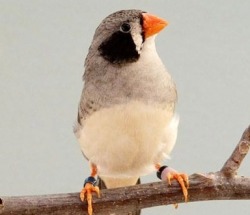
This is one of only two mutations where the hen has cheek patches. The female will have black cheek patches similar to the male's. They should not have other male markings, but it is not uncommon for a hen to show smudges in the flanks. The Black Cheeked hen is $45 each or $75 per pair contact for availability [email protected]
Orange Breasted Male
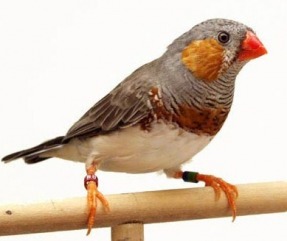
Male: The Orange Breasted mutation works to change the black markings to orange. The breast bar, throat stripes, tear mark and tail bars will change to orange. With the tear mark changed to orange, it will appear as though the mark is missing next to the cheek patch. Ideally, these birds will show all orange where the black breast will show black; however, there are many variations to the coloring of this mutation
Female: The tear mark and tail bars should change to orange. The tear mark can be difficult to spot and may appear to be missing.
Fledgling: Young OBs can often be identified by the lack of tear marks and orange in the tail bars. They will resemble female OBs.
The Orange Breasted male is $50 each or $85 per pair contact for availability [email protected]
Female: The tear mark and tail bars should change to orange. The tear mark can be difficult to spot and may appear to be missing.
Fledgling: Young OBs can often be identified by the lack of tear marks and orange in the tail bars. They will resemble female OBs.
The Orange Breasted male is $50 each or $85 per pair contact for availability [email protected]
Phaeo male
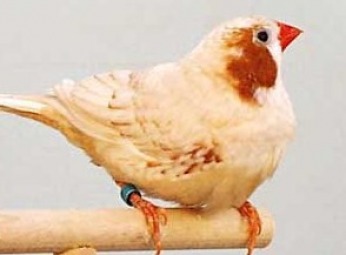
One of the most striking zebra finch mutations is the Phaeo zebra finch. This bird is not a separate mutation, but a cross between a Florida Fancy and a Black Cheek. The goal is to have a male bird with a completely orange head and breast on a mostly white bird. The color can vary quite significantly, but as this bird is the basis of many other zebra mutations, it is worth the time needed to produce a good one These zebras show extensive orange color on a nearly white bird. This combination shows all the orange features of a Black breasted with no black pigment is present.
The female Phaeos are similar to Florida Fancy hens but show a rich buff underparts and distince buff colored rump and tail coverts.
The phaeo is $60 per male or $100 per pair contact for availability at [email protected]
The female Phaeos are similar to Florida Fancy hens but show a rich buff underparts and distince buff colored rump and tail coverts.
The phaeo is $60 per male or $100 per pair contact for availability at [email protected]
OTHER COLOR COMBINATIONS OF THE BLACK AND/OR ORANGE ZEBRA FINCH MUTATIONS COMING SOON.......
fawn & white society finches

Males and females are identical in appearance. The only way to sex them is by behavior. The males will sing a song typical of many mannikins. With an upstretched neck and fluffed feathers, he will sing his warbling song and bounce back and forth on the perch while approaching the hen. Here are the fawn and white society finches they are (unsexed) meaning you might get a male or female they are $15 each contact for availability [email protected]
